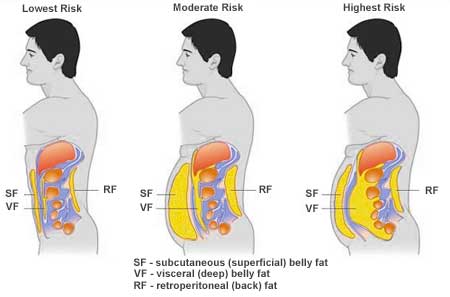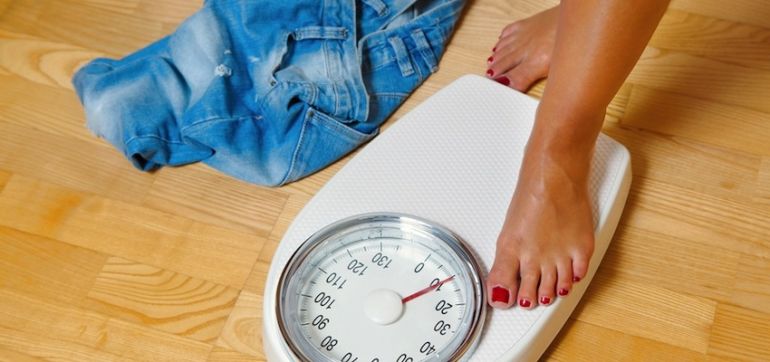Belly Fat Health Risks
 Belly fat is made up of two types of body fat – subcutaneous fat and visceral fat. Subcutaneous fat is the kind everyone knows about, the type under the skin. When you pinch a roll of fat – that’s subcutaneous belly fat. The second type of fat, visceral fat, is less well known and only of late better understood by scientists. You can’t pinch this deep belly fat, as it is hidden deep within the abdomen and lies out of reach. Fat in the lower body tends to be of the subcutaneous kind, while much of belly fat is visceral fat.
Belly fat is made up of two types of body fat – subcutaneous fat and visceral fat. Subcutaneous fat is the kind everyone knows about, the type under the skin. When you pinch a roll of fat – that’s subcutaneous belly fat. The second type of fat, visceral fat, is less well known and only of late better understood by scientists. You can’t pinch this deep belly fat, as it is hidden deep within the abdomen and lies out of reach. Fat in the lower body tends to be of the subcutaneous kind, while much of belly fat is visceral fat.
Until only recently scientists believed that fat was simply a place to store excess energy, i.e. calories. They didn’t think fat actually did anything. Now we understand that in truth fat is biologically active – especially the deep belly fat. Deep belly fat is akin to a gland that produces hormones and other substances which can strongly affect our health. Excess body fat, particularly deep belly fat, disturbs the normal balance and functioning of these hormones with dire consequences.
BELLY FAT & HEALTH
Excess deep belly fat is also known as central obesity. Central obesity is not the same as normal obesity; you could have a normal body mass index, but suffer with central obesity (find out if you have too much belly fat.)
Excessive deep belly fat is associated with an increased risk – or forms a part – of a whole host of medical disorders:
- Heart disease
- Hypertension (high blood pressure)
- Insulin resistance
- Diabetes Mellitus Type 2
- Metabolic syndrome
- High triglycerides
- Low levels of high-density lipoprotein (HDL) – the “good” type of cholesterol
- Sleep apnea
- Stroke
- Certain types of cancer
- Alzheimer’s Disease (irrespective of overall body weight)
 Types of Belly Fat in People Carrying Low, Medium & High Levels of Belly Fat
Types of Belly Fat in People Carrying Low, Medium & High Levels of Belly Fat
HIDDEN BELLY FAT
Sometimes it’s easy to know if you have a lot of belly fat by just looking. However, you might think that if you have a healthy BMI that you are safe and this doesn’t apply to you (if you don’t know you BMI use this BMI calculator.) However, excessive belly fat and normal obesity are distinct entities. Of course if you are obese you are highly likely to have too much belly fat. Alas, the opposite doesn’t hold true. Just because you are of healthy weight, doesn’t mean you don’t have unhealthy levels of body fat – or belly fat.
BMI is based on weight and height, but it doesn’t distinguish between fat and muscle. In other words, a muscular athlete could have little fat, but a high BMI due to the large amount of muscle mass. On the other hand, you may have little muscle, but a lot of fat. BMI deems your weight healthy, but in truth you may have unhealthy levels of body fat. Furthermore, you may have little of the superficial (subcutaneous) fat, but a lot of deep belly fat. Deep belly fat lies hidden in the abdomen and you may not have the classic telltale sign of of surfeit belly fat – a protruding pot belly. Looking slim and being slim are very different.
Research shows that you could be healthy weight or even underweight, but still suffer with unhealthy levels of belly fat. One study found that almost half its participants with a normal BMI score had excessive amounts of belly fat around the vital organs and fat streaked through their muscle. The moral of the story is this, no matter what weight you are, unless you are active and consuming a relatively healthy diet, your body may be hiding unhealthy levels of belly fat.
That was the bad news. The good news is this, exercise and diet help you lose deep belly fat pretty easily. Losing belly fat helps reverse the above health risks and also decreases blood pressure and improves cholesterol levels. The superficial belly fat is more difficult to shift if you are healthy weight, but it isn’t something that a solid exercise and diet strategy can’t solve.
To lose belly fat you need to implement the following:
- Diet to lose belly fat. There are some foods that may increase belly fat, while others help you lose belly fat.
- Cardiovascular exercise to lose belly fat. This will help you create a greater calorie deficit and increase metabolism helping you lose belly fat. Research suggests that some forms of physical activity are more effective than others to lose belly fat.
- Strength training to lose belly fat. This may help fight belly fat and also stops the muscle loss that occurs during weight loss.
- Use the weight loss calculators, exercise calculators and calorie calculators to help you get started.
- Learn about macronutrient ratios, protein, fat and the different types of carbohydrates to help you lose belly fat.
- Find out about the benefits of exercise, beyond losing belly fat.
Click to see references
-
Greatest Food regimen Patch ? Quick, Convenient Approach of Shedding Weight
Today, an increasing number of individuals are trying to get their phy
-
5 Secrets of Naturally Thin People + How I Became One
-
A Diet Which Blends A Few Idea Together
It seems that it is more difficult to have something really original n
-
7 Natural Remedies To Get Rid Of Cellulite
Cellulite affects up to 95% of the femal
-
7 Keys to Choosing the Best Supplements
With thousands of nutritional supplements on the market today, how
-
Lose Weight Fast and Safe – What You Really Should to Know
To lose weight fast and safe, you need to start out with the end in mi
- DON'T MISS
- Self-employed? How to stop overeating when you are working from home
- How Can Men Lose Weight Fast
- How To Lose Fat And Become Healthy Again?
- Evaluating The Weight Loss Cure Product Review Information
- The Burn the Fat Feed the Muscle Scam: You Decide
- If You Are Looking To Lose Weight, You Need To Ditch This Habit Permanently
- For Men, Its More Waist Management Than Weight Management
- Get Your Best Summer Body Ever: Six Cardio Moves
- Go Have A Cheat Meal
- Healthy Diets To Lose Weight: What Foods To Eat To Lose Weight




